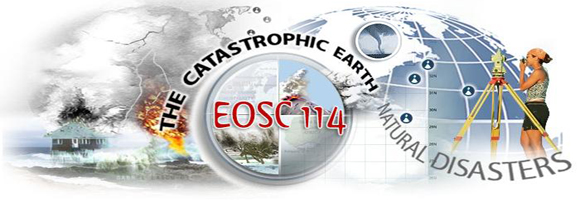
Course Description
Student Profile
Jessica Lu, Upper Level Biology Major

“I learned a lot about our earth and also the geological area of British Columbia that I never knew before!”
Earth and Ocean Sciences 114: The Catastrophic Earth – Natural Disasters. EOSC 114 focuses on the causes and physical characteristics of disasters such as volcanic eruptions, earthquakes, tsunami, hurricanes, storm surge, thunderstorms, tornadoes, landslides, wind waves, meteor impacts, mass extinctions. There are no prerequisites.
Student or Audience Description
This course is an introductory science course and is open to all students who need an engaging and personally relevant course to fulfill the earth science, physical science, or general science credit requirements for their degree at any Canadian college or university. This course is designed for students with a general interest in the Earth sciences, science students interested in learning how scientific methods are applied in the Earth sciences, students wishing to take the course for their own interest, and school teachers seeking continuing education.
Topics to be Covered
This course is presented in 7 lessons. Following is a brief description of the course content:
| Lesson 1: | A Fragile System Motivation: Types of natural disasters. Current disasters. Natural processes affect every component of the Earth system every day. Some of these processes, such as landslides, earthquakes, and tsunami, can have enormous negative impacts on humans and their interests, activities, and life. In this lesson, you will review basic concepts of mass, time, space, and energy, which will be helpful in understanding how and why natural processes can be disastrous to humans. You will also learn why an important component of the Earth is a “Fragile System” relative to natural disasters. |
| Lesson 2: | The Shaking Earth Motivation: Earthquakes In this lesson you will learn about the Earth’s large scale movements (earthquakes) starting from a local context, then moving to a regional, and finally a global context. You will learn the fundamental concepts needed to understand plate tectonics, faults, earthquakes, seismic waves, and damage mitigation. Many historical examples are provided and ways in which to reduce the harmful effects of earthquakes are discussed. |
| Lesson 3: | The Explosive Earth Motivation: Volcanoes In this section of the course, you will first study basic volcanic processes and the factors that determine a volcano’s explosivity; this is helpful in assessing how dangerous an individual volcano may be. You will also investigate different types of volcanic hazards associated with specific volcano morphologies and learn how volcanologists predict volcanic eruptions. Finally, you will incorporate your knowledge from the previous volcanism units into a plate tectonic framework to better understand how volcanism is influenced by various plate interactions. |
| Lesson 4: | The Unstable Ground Motivation: Landslides In this lesson you will first examine the major factors that influence slope failure, such as shear strength and shear stress, as well as study the important role gravity plays in mass wasting events. You will then apply these stress/strain concepts to various factors related to landslide causes and triggers to help understand how these factors play a role in landslide prediction. You will also study different landslide types and the dangers associated with select landslides through case studies from British Columbia and around the world. Finally, you will apply your knowledge to the evaluation of the landslide risk in British Columbia, specifically along the Sea-to-Sky corridor, and examine landslide prevention and mitigation techniques employed there. |
| Lesson 5: | The Turbulent Atmosphere Motivation: Storms In this lesson you will learn how storms look, how they behave, and why they behave that way. Your focus will be on thunderstorms, tornadoes, and hurricanes. You will become the detective (e.g., a forensic meteorologist) as you: locate where energy is produced, follow the clues as the energy is drawn into the storms, and catch storms at their greatest fury. By analogy with engines, you will see how the heat in storms can drive their violent winds. You will witness images of the beauty and the power of storms, and will improve you ability to make safer life-planning decisions. |
| Lesson 6: | The Violent Ocean Motivation: Waves The Earth’s surface is dominated by a single great ocean of liquid water. This global ocean borders most of the world’s largest cities, is a major transportation route, and provides food, oil, gas, and other resources, and of course, is a most enjoyable recreational resource. Unfortunately for the millions of people who live near the coast, certain oceanic phenomena can cause tremendous damage, destruction, and death. In this lesson on the Violent Ocean, you will begin with the study of the relationship between water, waves, and energy. You will then study several types of destructive oceanic waves, the dangers posed by these phenomena, and ways to mitigate their destructive and fatal effects through case studies from BC and the rest of the world. Finally, you will learn how man’s activities on land and man-made structures along the coast have become a significant factor in intensifying the destructive effects of oceanic waves. |
| Lesson 7: | Impacts from Space. Motivation: Meteor impacts and other mechanisms for mass extinctions To lay the foundation for better understanding mass extinction events, you will first learn basic Earth Science concepts such as the importance of the fossil record, the relationship between the biosphere and other Earth systems, and the frequency of extinctions through geologic time. You will then examine the evidence for the Cretaceous/Tertiary (K/T) extinction and discuss possible causes for that extinction. You will also study the present likelihood of a mass-extinction-causing meteorite impact by looking at meteor influx rates, sources of meteoroids, extinction periodicity, and historic meteorite impacts. Various mitigation strategies for impact hazards will be the final topic. |
Evaluation
Your course grade will be determined from 5 Unit quizzes and a final exam with the quizzes worth 60% of your course grade and the final exam accounting for 40%. The Unit quizzes include questions that cover on-line course notes and assigned readings from the textbook.
For information regarding the final exam please visit the Exams page.
Required Reading Materials
The Catastrophic Earth, Natural Disasters by Keller, E.A., R.H. Blodgett, and J.J. Clague. 2010.
3rd Custom Edition for UBC.
ISBN unknown; ISBN 978-0138000622 (used textbook)
The 3rd edition will be available mid-August 2010.
Note: The 3rd edition is what is required; however, the 2nd edition is acceptable.
